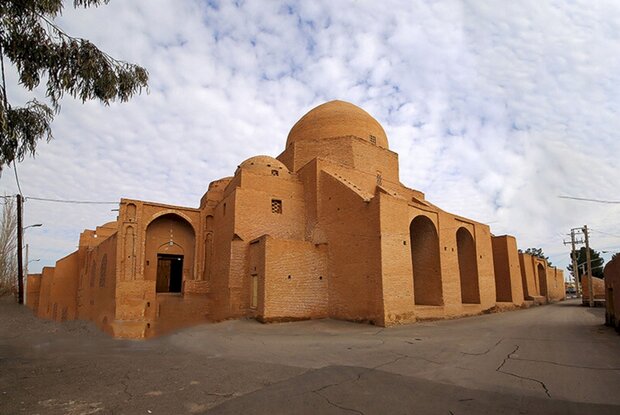Jameh Mosque of Ardestan: place of worship or museum of architectural styles

TEHRAN – Named after an oasis town in the heart of the Iranian Plateau, the Jameh Mosque of Ardestan is one of the best-preserved places of worship that still features a variety of ancient architectural styles.
Situated in Isfahan province, Ardestan was one of the most flourishing towns of the region during the Middle Ages, mostly renowned for its pomegranates, and silk production.
The two-story hypostyle mosque is an early Islamic building with many accretions over its long history of use. It incorporates successive architectural styles of the Sassanids, Buyids, Seljuks, and Safavids.
However, a majority of what its visitors see date from the Seljuk era (ca. 1040–1196). According to Encyclopædia Iranica, most of the Seljuk decoration is concentrated within the sanctuary while the dome chamber closely follows the pattern of the Isfahan school in its multiple lower openings and its zone of transition.
The congregational mosque has a four-portico (iwan) courtyard surrounded by encircling arcades. However, it is part of larger premises that also include other mudbrick structures such as a cistern, a caravanserai, a marketplace, a bathhouse, and a madrasa.
According to Archnet, the earliest stucco fragments, found in the western corner of the courtyard, have been dated to the end of the 10th/4th c. AH. The interior of the dome chamber and iwan are extensively covered in plaster. The dome and zone of transition are articulated with simulated brickwork; the iwan vault is uniquely faced with a complex stucco design of interlacing arabesques. The mihrab exemplifies skilled stucco carving and may represent Mongol restoration.
The mosque stands on a site once occupied by a Sasanian structure, as evidenced by remains discovered in archaeological excavations. Its earlier structure was likely a hypostyle type, having a central courtyard surrounded by arcades. Remains of some of these arcades in the current mosque show that they were covered with barrel vaults. The mosque occupies an irregular space centered on a rectangular courtyard with four iwans, incorporating pieces of the earlier hypostyle structure.

The iwans on the southwest (qibla) and northeast sides of the courtyard are larger, rising to a greater height and being wider as well. Behind the southwest iwan is a square chamber surmounted by a dome resting on an octagonal transition zone formed by eight engaged arches. Between the iwans are vaulted bays of irregular size and shape on two stories. Behind the vaulted bays in the southern quadrant of the mosque, a long corridor leads from two entrances onto the vaulted bays on the southeastern side of the courtyard.
Furthermore, the exterior of the mosque is quite irregular while the facades of the courtyard are harmonious, with the iwans aligned and roughly the same size, not unlike the situation in the Great Mosque of Isfahan, which also evolved over centuries and went through a major renovation during the Seljuk period. Currently, the mosque has several entrances.
The earliest dated inscription on the building is from the 12th/6th c. AH, but evidence of an earlier mosque remains, suggesting that its original foundation could date to the 10th-11th/4th-5th c. AH or earlier.
Archaeological evidence suggests that the earliest additions to the mosque that transformed its plan from the original hypostyle type were likely the southwest iwan and dome chamber behind it (dated by inscriptions to 1158/553 AH and 1160/555 AH respectively).
These were inserted into the existing hypostyle prayer hall on the southwestern side of the courtyard. Scholars debate the dates of the remaining three iwans, some believing that they were constructed in the twelfth/sixth century and others arguing for a later date, as an inscription in the northeast iwan dates to 1539/946 AH.
Last year, Iran compiled a dossier for a possible inscription of the mosque on the UNESCO World Heritage list as the "world’s first" two-story mosque, Ardestan’s tourism chief has said.
“Jameh Mosque of Ardestan is arguably one of the finest works of Islamic architecture in the whole country, and it should be preserved to the fullest extent possible,” the official added.
The mosque was inscribed on the national heritage list in 1931.
AFM
Leave a Comment